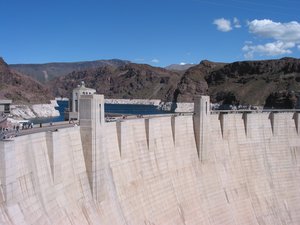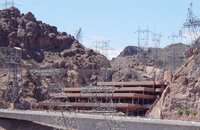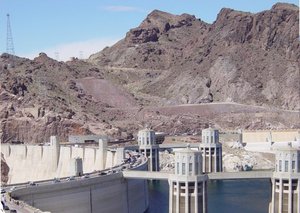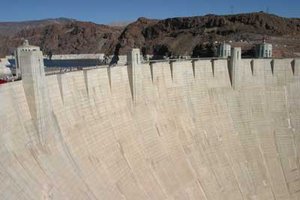Hoover Dam
|
|
Hoover Dam (Template:Coor dms) is a concrete gravity-arch dam in the Black Canyon of the Colorado River, on the border between Arizona and Nevada. The dam, located 48 kilometres (30 miles) southeast of Las Vegas, is named after Herbert Hoover, who played an instrumental role in its construction, first as Secretary of Commerce and then later as President of the United States. Hoover Dam was built by Six Companies, Inc., under Frank Crowe. Construction began in 1931 and was completed in 1936, over two years ahead of schedule. The dam is operated by the Bureau of Reclamation of the U.S. Department of the Interior.
Lake Mead is the reservoir created behind the dam, named after Elwood Mead who oversaw the construction of the dam.
| Contents |
History
Before the construction of the dam, the Colorado River Basin periodically overflowed its banks when snow from the Rocky Mountains melted and drained into the river. These floods endangered downstream farming communities.
IMG_0029.JPG
In 1921, Herbert Hoover, who was then Secretary of Commerce under President Calvin Coolidge, proposed construction of a high dam in Boulder Canyon to control the periodic floods and to store water for irrigation, municipal, and industrial use. He envisioned that the dam would be self-supporting, financed through the sale of hydroelectric power generated at the dam.
In January 1922, Hoover met with the state governors of Arizona, California, Colorado, Nevada, New Mexico, Utah and Wyoming to work out an equitable arrangement for apportioning the waters of the Colorado River for their states' use. The resulting Colorado River Compact, signed on November 24, 1922, split the river basin into upper and lower halves with the states within each region deciding how the water would be divided. This agreement paved the way for the Boulder Dam Project, which was initiated in 1930. By then, Hoover had replaced Coolidge as President.
Built during the Great Depression, over 100 workers died during the construction of the four diversion tunnels and dam, which were not ventilated. Crews of "icebox men" would run into the tunnels and wrap heat-afflicted workers in ice to try and cool them down, but this would often not be enough. Many of the workers' wives and children also died from the extreme heat and lack of sanitation they had to endure in the squalid camps like Ragtown which quickly grew around the dam site. Six Companies, Inc. was contracted to build a new town for construction workers, to be called Boulder City, but Frank Crowe preferred to concentrate efforts on the tunnels and dam. Crowe was fearful of winter floods and the financial penalties he would suffer if the project fell behind schedule. However, discontent with Ragtown and the dangerous working conditions led to a strike on August 8 1931. Six Companies responded by sending in strike-breakers with guns and clubs, and the strike was soon quashed. But the discontent prompted the authorities to speed up the construction of Boulder City, and by the spring of 1932 Ragtown had been deserted. [1] (http://www.bbc.co.uk/history/society_culture/industrialisation/hoover_dam_05.shtml).
Generators at the Dam's Hoover Powerplant began to transmit electricity from the Colorado River a distance of 266 miles (364 km) to Los Angeles, California on October 9, 1936. Additional generating units were added through 1961. The seventeen main turbines at this powerhouse generate 2,074 megawatts of hydroelectric power. The dam and powerplant are operated by the S Chow and United States Department of the Interior's Bureau of Reclamation.
In addition to its economic and engineering renown, Hoover Dam is accounted a masterpiece of Art Deco design.
Statistics
Missing image DamTimeZones.jpg The dam crosses the border between two time zones, the Pacific Standard Time Zone the Mountain Standard Time Zone |
- Construction period: April 20, 1931 - March 1, 1936
- Construction cost: $165 million
- Dam Height: 726.4 ft (221.4 m), 2nd highest dam in the United States.
- Dam Thickness: 660 ft (200 m) at its base; 45 ft (15 m) thick at its crest.
- Concrete: 4.36 million yd³ (3.33 million m³)
- Traffic across the dam: 13,000 to 16,000 people each day, according to the Federal Highway Administration
- Lake Mead surface area: 247 square miles (640 km²), backing up 110 miles (177 km) behind the dam.
- Lake Mead water volume: approximately 46,000,000,000 yd³ (35.2 km³), or 28.5 million acre-feet.
- With 8 to 10 million visitors each year, including visitors to Hoover Dam but not all traffic across the dam, the Lake Mead National Recreation Area is the 5th busiest U.S. national park.
The naming controversy
The dam, originally planned for a location in Boulder Canyon, was relocated to Black Canyon for better impoundment, but was still known as the Boulder Dam project. Work on the project started on July 7, 1930. At the official beginning of the project on September 17, 1930, President Hoover's Secretary of the Interior Ray L. Wilbur, announced the name as Hoover Dam. Hoover was already campaigning for re-election in the face of the Depression and sought credit for creating jobs.
Hoover did not win, and on May 8, 1933, President Franklin D. Roosevelt's Secretary of the Interior, Harold L. Ickes, renamed the dam Boulder Dam. The intent was to deny Hoover credit, though the dam had been begun in his administration. Finally, on April 30, 1947, President Harry S. Truman signed legislation restoring the name Hoover Dam.
Crooked pylons of outgoing powerlines
Because the transformer station of Hoover Dam is placed in the narrow valley of Colorado river, it was not easy to find a right of way for the powerlines leaving it. Therefore some crook pylons have been built close to the valley, which are inclined considerably to the vertical (see picture).
External links
- Hoover Dam's official website (http://www.usbr.gov/lc/hooverdam/)
- Structurae: Hoover Dam (http://www.structurae.de/en/structures/data/s0000136/index.cfm)
- BBC - Hoover Dam, industrial and social history (http://www.bbc.co.uk/history/society_culture/industrialisation/hoover_dam_01.shtml)
- Hoover Dam page (http://www.sunsetcities.com/hoover-dam.html)
- Dams of the Lower Colorado River - Hoover Dam (http://www.citlink.net/~davegun/hdIX.html)
- Frank Crowe - Builder of Hoover Dam (http://www.1st100.com/part1/crowe.html)
- "Boulder Dam" – Part I (http://www.archive.org/details/BoulderD1931) and Parts III and IV (http://www.archive.org/details/BoulderD1931_2), documentary films from the Prelinger Archive at the Internet Archive.
Template:Geolinks-US-streetscale Template:Geolinks-US-locde:Hooverstaudamm fi:Hooverin pato




